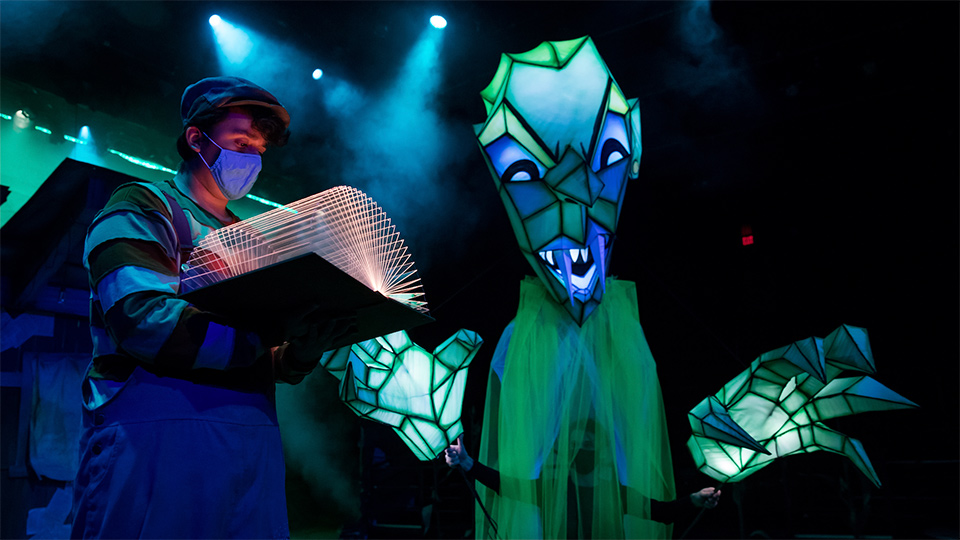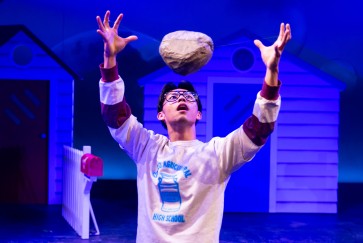Staging a theater production is no small task. Production meetings begin months before the curtain goes up. Auditions can take weeks. There are also weeks of table reads of the script for the entire cast and production team. While all of this is going on, carpenters build the set and props. In the costume shop, sewers race to meet deadlines. Lighting designers hang lights so rehearsals can begin in the theater space on time.
That’s all in normal times. We are far from “normal” right now. But the show must go on.
For the first time since the COVID-19 pandemic shut down campus theater productions one year ago, Northwestern’s Wirtz Center is raising the curtain once again. The Imagine U production of “Tomás and the Library Lady” will be presented to virtual audiences during the next three weekends — March 12-28.
The play by Jose Cruz Gonzales is adapted from Pat Mora’s award-winning children’s book. The story follows young Tomás, the son of Mexican migrant workers. Tomás struggles to read and speak English and fit in at school. But with the help of a kind librarian and the power of imagination and curiosity, he overcomes his fears and realizes his passion for reading and writing, which enables him to rewrite his own story.
 Ismael Lara, Jr. and fellow students got creative in bringing back live theater.
Ismael Lara, Jr. and fellow students got creative in bringing back live theater.
School of Communication MFA directing student, Ismael Lara, Jr. (pictured), calls the production “an experiment.” He and his team found a creative way to bring back “live” theater to Northwestern through a tough process of filming scenes, prerecording dialogue and the use of puppets. Strict COVID safety guidelines were enforced during the production, including social distancing and the wearing of masks by student actors and production crew. Others in the cast and crew attended rehearsals via Zoom.
Lara shares his thoughts on producing a play during a pandemic.
Technically, how is “Tomás” different from any play you’ve been involved with pre-COVID?
We discussed with the Wirtz Center staff that we would need to have at least four backup plans. It took a lot more planning than a regular production would take. Table readings and rehearsals were on Zoom. I had a small model that was built by the scenic designer. I was moving miniature figures around the stage, in order for the actors to take down their blocking, and then they would walk it out in their own spaces at home. The music director would teach each actor their track, and then have them mute themselves and have them sing along to the actual track record of themselves singing. We had to rethink things the first time that the actors were using the actual set, using their actual props in space with one another, and trying to figure out how to establish relationship whenever you’re six feet apart, while you have masks on.
Describe the filming process. You had multiple cameras capturing several angles in the Barber Theater.
To be safe as possible, we limited the number of actors in the space, and everyone kept masks on during filming. We recorded the entire audio of the play, and the actors had to perform in a different way to the audio that is playing. With the magic of editing, we were able to make it appear that that the stage was filled.
What is different about filming a play versus having a live audience?
When an audience is in the theater, you can sort of see their reactions, and you can feel their energy. They are on the receiving end of the story that we're telling. And whenever you have actors on stage, who are not performing for an audience, there is something that is missing. And so, as a director, along with all of my team, we have to constantly remind the actors, you're in front of an audience right now, so that they can envision them, and try to bring the same spirit that they would whenever an audience is in the space.
How did puppets become a useful tool to tell this story?
When we started this project, there was a fear that the actors wouldn't be able to really communicate because of the masks. And so we thought, how can we create a sense of tangible communication other than with our mouths, and the first idea was puppets. And from that, grew this excitement from the costume shop and the prop shop. And what they have created are these really beautiful cardboard figures that when you look at them, they are completely conveying an emotional story. And I think that, this play, at least in this moment with us wearing masks, I'm not sure that it could be told without these puppets.
How does it make you feel to be the first to bring back theater to the Northwestern community?
I don't know how to answer that question without flooding the stage with my tears. Yeah, it's a learning experience for us all, and it does make us appreciate theater that much more. Every time I see someone who is working on the project, making certain that I look at them and tell them thank you for all the work that they are doing during this moment. There are so many humans who are feeling as if they're trapped. They don't have this opportunity. And I feel a little guilty sometimes to be sitting in the theater and watching these actors work and to be collaborating with beautiful human beings.
Imagine U’s “Tomás and the Library Lady” is streaming March 12-14; March 19-21; and March 26-28. Household admission is $20. Admission is free for Northwestern students with a valid NU email address by filling out this required registration form.
For reservations and more information, visit the Wirtz Center website.


